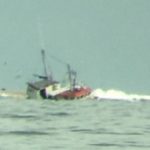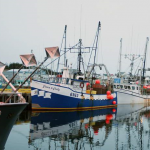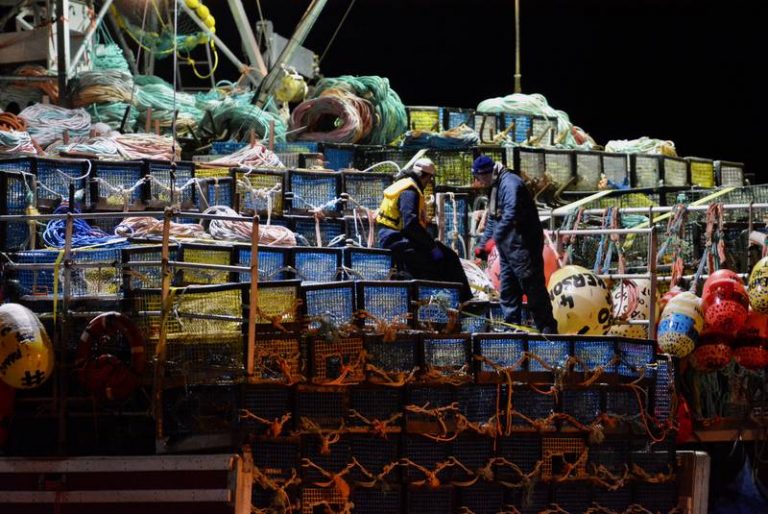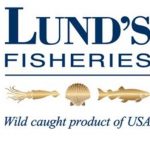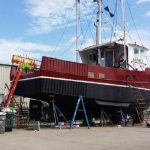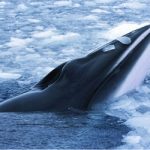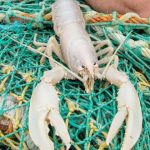Search Results for: Jim Lovgren

With Coronavirus pandemic ravaging our country, temporary relaxation of fishery regulations is urged to help fishing industry
Thanks to our Senators and Congressmen who worked to get specific aid to the fishing industry, that has been hit particularly hard by the closure of restaurants, where 70 per cent of seafood in this country is consumed. Fishermen and wholesalers have had to adapt on the fly and find other ways to market their product to various degrees of success. The closure of so many vital aspects of our domestic economy will have effects that will still be felt a long time after the Virus is tamed.,, I am requesting that NMFS immediately contact the various management councils and commissions to request that special meetings [webinars] of fishery advisory panels be held to discuss the pro’s and cons of this idea, and what fisheries could benefit.,,, By Jim Lovgren. >click to read< 20:48
With Coronavirus pandemic ravaging our country, temporary relaxation of fishery regulations is urged to help fishing industry
 With the Corona pandemic ravaging our country, and the rest of the world, causing death and economic destruction everywhere, our government has stepped up to the plate and delivered a number of welcomed economic stimulus aid packages. Thanks to our Senators and Congressmen who worked to get specific aid to the fishing industry, that has been hit particularly hard by the closure of restaurants, where 70 per cent of seafood in this country is consumed. Fishermen and wholesalers have had to adapt on the fly and find other ways to market their product to various degrees of success. The closure of so many vital aspects of our domestic economy will have effects that will still be felt a long time after the Virus is tamed. Many small businesses are not going to be able to survive a lengthy shutdown, and with no money coming in for them they will default on money owed. This will cause a chain reaction up the supply line, from restaurants and fish markets, to their wholesale suppliers, to the first point of sale at the unloading dock, and then the boat. Everyone in the seafood business will be negatively touched by this chain bankruptcy, I just hope that the aid package takes into account this damaging problem, which will also affect all types of businesses throughout the country. Regarding the aid package, it is complicated and I recommend getting legal advice on how best to apply.
With the Corona pandemic ravaging our country, and the rest of the world, causing death and economic destruction everywhere, our government has stepped up to the plate and delivered a number of welcomed economic stimulus aid packages. Thanks to our Senators and Congressmen who worked to get specific aid to the fishing industry, that has been hit particularly hard by the closure of restaurants, where 70 per cent of seafood in this country is consumed. Fishermen and wholesalers have had to adapt on the fly and find other ways to market their product to various degrees of success. The closure of so many vital aspects of our domestic economy will have effects that will still be felt a long time after the Virus is tamed. Many small businesses are not going to be able to survive a lengthy shutdown, and with no money coming in for them they will default on money owed. This will cause a chain reaction up the supply line, from restaurants and fish markets, to their wholesale suppliers, to the first point of sale at the unloading dock, and then the boat. Everyone in the seafood business will be negatively touched by this chain bankruptcy, I just hope that the aid package takes into account this damaging problem, which will also affect all types of businesses throughout the country. Regarding the aid package, it is complicated and I recommend getting legal advice on how best to apply.
In regard to fishery regulations, NMFS has acted quickly to address the health issue of Fishery observers being placed on vessels at this time of an unprecedented national pandemic by suspending their operations. This is a good thing for all involved especially when social distancing is hard to practice on a fishing boat. There are a number of things that NMFS can do to help both the commercial and recreational fishing industry’s by temporarily relaxing some regulations on stocks that are healthy and could withstand a little extra effort.
Recreational fishermen are watching as the beginning of some of their seasons have started and they are not able to participate. [MRIP numbers next year will probably still show record landings for this period]. Since most of these fisheries take place in state waters, regulations vary state by state, and are managed by coastal commissions, such as the Atlantic States Marine Fishery Commission. They still are bound by the harvest quota’s that are set by the stock assessment scientists in our regional fishery science centers. In light of the economic damage being caused by the closure of much of our economy many people will find themselves out of work and not even being able to afford food to feed their families. Here is where our state and federal government can help without spending much money. A temporary reduction in recreational size limits, bag limits and a lengthening of seasons for certain species of fish that are considered healthy and not overfished, should be implemented on a state by state, specie by specie basis. Special consideration should be given to the Party and Charter boat industry’s as they have been the hardest hit segment of the fishing industry.
On the east coast a perfect opportunity exists to do what many fishermen have been asking for years, reduce the minimum size limit of recreational caught Summer Flounder. Many states have minimum size limits of 18 inches or more and the discard problem is well documented as fishermen throw over 20 fish to keep one. This summer, reduce the size limit to 16 inches, which will also reduce the discard ratio and not harm the stock. Since management has not been able to address this issue for various reasons, an emergency may be the best chance to open the eyes of those who insist on killing all the spawning stock biomass. [90% of summer Flounder over 18 inches are female]. Presently in New Jersey the Blackfish season is open, yet no one can participate, this presents the opportunity to either increase the bag limit or lengthen the season, while not actually affecting the over all catch of this species which is overfished. In every state in our country opportunities are there to help feed the public if our fishery managers are allowed to address them, and that takes Federal cooperation.
There are also opportunities to help commercial fisheries by a temporary relaxation of regulations. The New Jersey Lobster fishery is set for a mandatory closure for all of May, in which all pots must be removed from the water. This not only presents a problem for the work and expenses of
lifting the gear and bringing it home, but also then returning them to the water a month later. This closure is mandated by the ASMFC to address overfishing, but the problem with Lobsters in both New Jersey and New York is not overfishing, it is Climate induced, and the closure will not affect the
population, they’re busy moving east to cooler climes. Keep the season open this year to help these fishermen out, since this is a time sensitive problem emergency action needs to take place for it to happen. Throughout our country there are opportunities to help out the fishing industry without using public funds by temporary measures to allow increases in quota, reductions in regulations, or changes in bag and size limits or seasons.
I am requesting that NMFS immediately contact the various management councils and commissions to request that special meetings [webinars] of fishery advisory panels be held to discuss the pro’s and cons of this idea, and what fisheries could benefit. The domestic fishing industry has had
to find alternative methods to sell their product, and the American public is reacting positively to it by being able to eat fresh off the boat seafood. Years ago one of the tasks that was given to the National Marine Fishery Service was the protection and promotion of the domestic fishing industry, we see how well that worked out with seafood imports now dominating the market. When the regional fishery management councils were created they were complimented by regional fishery development councils. Most of these died a slow death 30 years ago as the money did not go where it was needed in most cases but to Grant hungry bureaucrats who wasted a lot of it. Staltonstal Kennedy funds provided that money and it has been high jacked by every government department that could lay reasonable claim to it. Maybe somebody can find some money to do national level advertising to promote fresh US produced seafood like the money was originally intended to do.
Thank you, Jim Lovgren
Looking Back: 2007-Wake up New Jersey before more of your tax dollars are wasted on Governor Corzine’s offshore windfarm
 Wake up New Jersey before more of your tax dollars are wasted on Governor Corzine’s offshore windfarm. The Governor is proposing to create a huge 80 unit windfarm capable of producing 350 megawatts of electricity in the waters off the south Jersey shore at an estimated present cost of 1.5 billion dollars. Last week New York cancelled plans for a smaller farm, of about 40 windmills, off of Jones beach because of rising cost estimates already over 700 million dollars for a project originally projected to cost about 200 million. New York officials were smart enough to recognize a financial black hole before they started it. Are New Jersey officials?
Wake up New Jersey before more of your tax dollars are wasted on Governor Corzine’s offshore windfarm. The Governor is proposing to create a huge 80 unit windfarm capable of producing 350 megawatts of electricity in the waters off the south Jersey shore at an estimated present cost of 1.5 billion dollars. Last week New York cancelled plans for a smaller farm, of about 40 windmills, off of Jones beach because of rising cost estimates already over 700 million dollars for a project originally projected to cost about 200 million. New York officials were smart enough to recognize a financial black hole before they started it. Are New Jersey officials?
Our energy policy should first and foremost be about economics, while factoring into account the environmental effects both positive, and negative of the various types of energy production. Oil is supposed to be the cheapest energy source available, but the real cost of oil consumption should be measured in the lives that are lost on foreign battlefields to protect our so-called national interests. Add onto that the five hundred billion our military has spent in Iraq alone to provide Big oil with their record profits, and oil is not so cheap anymore. Biofuels are cost prohibitive without huge government subsidies, and are now causing large food price increases. Nuclear power while clean, has that little waste disposal problem that has not yet been solved, besides those antique units that still depend on estuarine waters for cooling and single handedly kill more marine life than the commercial and recreational fishing industries combined.
Wind power production while clean, its environmental effects on the marine ecosystem are unknown and the cost of a wind farm offshore is enormously more costly then a land based farm. Maintenance is also much higher on the ocean due to the harsh environment and the corrosive effects of salt water. A large European wind farm required helicopters to transport repairmen to the turbines when needed. Will we also need helicopters for simple repairs? What will be the real cost of building and maintaining this farm? Who will pay for it? [The energy company customers, YOU]. Remember the BRAC and how costs have escalated out of sight, this wind farm will do the same thing, and taxpayers, and ratepayers will foot the bill.
I realize the governor is a financial genius but lets do some math. 80 offshore windmills will produce 350 megawatts of electricity, enough to power 25,000 homes. This will cost at least one and a half billion dollars and probably twice that when all is said and done. By comparison for one and a half billion dollars, solar panels could be placed on 37,500 homes, figuring a average cost of 40,000 dollars per home, [ which should decrease as more production comes on line]. Most importantly the solar panels will produce the most energy when we need it , during the peak summer months, while
the windmills will sit idle producing most of their power in the fall, winter, and spring.
The energy produced by solar power is more valuable than wind power due to its being produced during the critical peak summer season. And guess what? Those 37,500 homeowners, will, after the initial cost of installation is paid, be faced with electric bills amounting to little or nothing at all. Sometimes the electric company will have to pay them when the panels produce more electric then the household uses. So what’s wrong with this picture?
The government and energy monopolies do not want individual citizens producing their own power. If all houses had solar panels, who would need electric utilities? If there were no electric utilities, who would replace all those large campaign contributions? In these days of hard financial times our state and federal governments need to invest taxpayer dollars wiser then they have, [that shouldn’t be too hard]. Alternative energy sources are needed, but they must realistically make financial sense. Windmills on land are border line cost effective and that’s only because of energy subsidies.
Windmills in the north Atlantic will never come close to recovering their cost. It’s a total scam, if something doesn’t make financial sense, then we should be looking at who will benefit from their construction. New Jersey citizens will not benefit from this ocean windfarm, electric costs will rise because of it. Someone needs to follow the money to see who exactly will benefit.
In the meantime lets build windmill farms where they are most economical. The most wind in this country is generated at our state and federal capitals, therefore we should surround each one of them with windfarms to take advantage of all the hot air. Our state and federal government’s should start a Manhattan project to fully realize the potential of solar power, and free our citizens from the utilities monopoly. Lastly, Governor Corzine needs to put solar panels where the sun shines, and windmills where it doesn’t!
Jim Lovgren
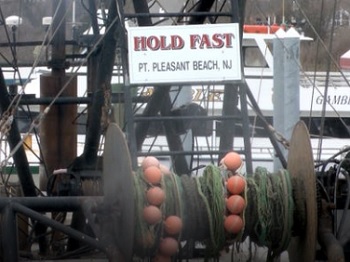
Coronavirus: Outdoor seafood market helps Point Beach fishermen sell catch
The commercial fishing industry, like many others, is reeling from social distancing orders. In the case of fishermen, two-thirds of their seafood is normally bought by restaurants, which have been reduced to takeout only. The co-operative’s fishermen are trying to find alternatives ways to sell their fish instead of bringing them to Fulton Fish Market in the Bronx, where wholesalers buy fish and move it to restaurants. “Prices have dropped by as much as 75 percent. I haven’t seen them this low since the 1980s,” said Jim Lovgren, who sits on the board of directors Fishermen’s Dock Cooperative, of Fulton’s prices. Video, photos, >click to read< 15:44
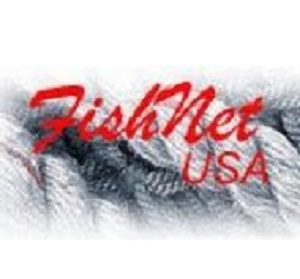
“With a bit of prodding by some valued colleagues”, we will be launching a series “Looking Back”
A few of us were conversing, and the topic of resurrecting’s some of the posts, pages, and information of the past to gauge the changes and improvement’s achieved though the past few decades of fishery management and sacrifice, or if there have been any improvements at all! Nils Stolpe, Jim Lovgren, and I thought perhaps these various posts and articles would give an indication of how the domestic fishing is doing! Both of these gentlemen are exceptional writers, with exceptional knowledge of the domestic fishing industry and they have been featured here many times. We hope people revisit these articles, and for many of the newer fishermen in the industry today, this may be the first exposure to this interesting, and valuable info, and other stories. We’ll kick it off with “With a bit of prodding by some valued colleagues,” >click to read< 13:07
WHAT’S THE BIG RUSH TO OFFSHORE WIND? – PART TWO

The U.S. government is apparently willing to destroy two of the most valuable fisheries on the east coast for the good of, are you ready? Foreign companies. The companies that have won the lease rights from the Bureau of Ocean Energy Management, [BOEM] are almost all primarily from Europe, Equinor is Norwegian, Orsted is Danish, Dong is multinational and based in the Cayman islands, which should tell you all you need to know about them as that is the tax shelter of every scoundrel in the world. Our politicians claim that the wind farms will create thousands of jobs, yet the turbines are built in Europe and will be shipped over for assembly. Because the US has no ships presently capable of handling 300 foot long turbine blades, [made of unrecyclable fiberglass] congress has passed legislation to exempt these foreign ships from the legal requirements of the 100 year old Jones act which was created to protect US shipping industries from foreign competition, requiring any US ships doing business in our territorial waters must be built in the US. That’s quite something since congress can’t find the time to pass critical health care legislation, or infrastructure bills.
No question about it, wind farms will create jobs, and good ones at that, hence the unions are all for them. Unfortunately most of the jobs will be temporary, during the planning and construction phase, after that its just maintenance. Which by the way will be enormous because no one has ever put wind farms in water so deep offshore and in the harsh north Atlantic environment before. Expect the windmills to have about half the life expectancy that they are claiming, and maintenance costs to far exceed expectations. What does that mean to you, the poor homeowner, or renter who needs electricity? Expect the cost of your electric bill to triple, as it has done in Europe. Wind farms will be the largest tax increase in history by the time it is said and done.
Why are windmills suddenly the answer to all our energy needs? They were obsolete one hundred years ago, but now are suddenly going to save the world, despite the fact that they have enormous environmental effects themselves, including avian genocide, besides the marine problems mentioned previously. Also, offshore wind will be most productive at the time we need it the least, the winter, which means expensive investments into energy storage facilities, or as they are now doing in Europe, paying the windmills more to shut down than for when they produce electric. What ever happened to solar energy, it seems like it has been forgotten, yet here is an energy source that has, once installed, a totally negative effect on the environment. It also produces its best energy at the time when we need it the most, the summer, peak season. Advances in technology have decreased the price so that it truly is competitive on the energy market, yet all subsidies have dried up, and the only solar being proposed is large farms owned by corporations. Why is this? Wouldn’t you think that investing in the localized production of electricity by individual homes and buildings which will result in a direct lowering of a person’s electric bill be a no brainer? Ask your self, would you rather have solar panels on your home and a lower electric bill, or would you rather pay exorbitant rates to an electric utility, that’s busy destroying the environment they are claiming to save?
There is presently another clean energy option that can be utilized immediately to meet the needs of the northeast, and that is to purchase energy from Canada where the construction of four new hydro electric plants has left them with a huge surplus of electricity. This should be a no-brainer but of course because so much money has now been invested in offshore wind I doubt it can be stopped, or even slowed down. Investors want immediate returns on their money which is why much of the green energy projects that get built, end up being refinanced soon after. Another option that needs serious consideration is the use of the floating platform wind turbine, where the turbine is mounted on a large bargelike vessel and deployed in deeper water off of the continental shelf where the turbine would have less environmental effects, and the siting and construction would be minimized. This technology is developing rapidly and is being planned for use off the U.S. west coast, where there is little to no continental shelf. Floating technology eliminates almost all interactions with the fishing industry and seriously reduces the environmental effects of all stages of the presently planned windfarms.
This brings us to the real question. How can an energy source with so many questions about its cost, and the effects it may have on the environment it is supposed to save be rammed down our collective throats without much opposition? Why aren’t the environmental crusaders, that previously have been so busy suing the NMFS to save the fisheries, raising the alarms about the marine issues I have raised? Have they been drinking from the waters of corporate contributions to their cause to buy their silence? Money can buy almost everything, in this case it buys hypocrisy. Many people in the fishing industry have been approached with the possibility of good paying jobs as liaisons, or to lead newly created fishing organizations that support windmills, and most have turned them down. The wind mill companies have been spreading around money like free peanut butter on bread, it seems like they have promised something to everybody, so that they can get their way.
There is no truer axiom then follow the money, so let’s do a little research and speculation. According to the “Clean Energy Impact Report” by Goldman Sachs in 2012, they established a target to finance and invest forty billion dollars in clean energy globally over the following decade. Just over four years later, they achieved this initial goal. In November 2015, they increased their existing target to 150 billion by 2025, expanding their ambitions and underscoring their commitment to mobilizing capitol to scale up clean energy and foster sustainable economic development”. Truly a noble cause, without financing and people willing to risk money societal progress would not take place. By deciding that wind was a better alternative than solar because their investors would get a better yield than if the average citizen was allowed the ability to invest in his own roof mounted solar system, the game then was to propagandize the sky is falling and we must save the world, by utilizing their multi-media mouth pieces. Offshore wind was targeted as the energy source with the most potential profit, not because of its economic efficiency but because they knew that no matter what, they could just increase the electric rates of a captive audience. It’s for a good cause after all.
But how could you do that on the east coast when you have a New Jersey governor [Chris Cristie] whose administration stymied any offshore wind project that was proposed? The answer in true Goldman Sachs tradition was to elect their own governor who would enact their projects. Just like Jon Corzine was elected to steer state and municipal bonds to Goldman Sachs for servicing the states debt, Phil Murphy appears to be the guy to shove windmills down everybody’s throat, like it or not. Governor Murphy has been virtually invisible in every aspect of his administration except for windmills. It’s hard to believe that a Goldman Sachs executive would give up that prestigious life and salary so that he can go on a Don Quixote quest to save the world, from a not quite certain fate. This is purely speculation on my part, but it sure makes sense if you think about it.
With Murphy in place, a race to propose and generate the most gigawatts of power was on between Murphy and Governor Cuomo of New York. Massachusetts and Rhode Island both had a head start on offshore wind but they have been overtaken by the New York Bight two-some. Windfarms are proposed from Cape Hatteras to Nantucket and the long term effects of their construction and operation is totally unknown, but those effects will not all be beneficial if they are at all. So much money is being thrown around by the windmill supporters that it makes your head spin. In New Jersey State Senator Steve Sweeny made sure to get his piece of the pie by having an important staging area for windmills in his district. I’m sure this is true in all the states, everybody’s hand is in the pie, except the general public who is going to get a pie in the face. So in answer to the question, “Why the big rush for offshore wind?” the answer appears to be because a lot of people are going to make a lot of money, and it will be your money they’re taking. I personally think its time for an FBI investigation into what has been taking place.
Jim Lovgren
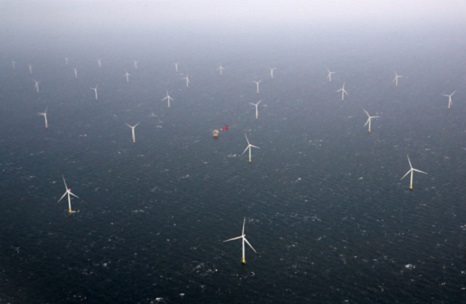
So! What’s the Big Rush to Offshore Wind?!! Part 1 and Part 2
The U.S. is currently in a mad rush to build offshore wind farms on every square inch of the ocean on the east coast, despite the fact that there is presently little known about the environmental effects of so many structures on the marine ecosystem. The surveying, construction, operation and maintenance of these huge, up to 900 foot tall structures, will create a cacophony of sound never before heard in these ocean waters.,, So, why must we ignore all semblances of concern to the possible effects of thousands of huge off shore wind turbines on the marine environment? By Commercial Fisherman Jim Lovgren. This is a two part series, >click to read< Part 1, >click to read< Part 2 23:04
WHATS THE BIG RUSH TO OFFSHORE WIND? – PART 1
Feb 4, 2020
The U.S. is currently in a mad rush to build offshore wind farms on every square inch of the ocean on the east coast, despite the fact that there is presently little known about the environmental effects of so many structures on the marine ecosystem. The surveying, construction, operation and maintenance of these huge, up to 900 foot tall structures, will create a cacophony of sound never before heard in these ocean waters. While the surveying and construction phase is supposed to be of short duration, consisting of sonic and seismic testing to explore the ocean bottom, and piledriving the windmill bases into the sea floor, because more and more projects are being proposed almost everyday, it’s not unreasonable to assume that this noise will be present for the next 25 years at least. What will the cumulative effect of all this noise, [some of it loud enough to kill creatures] be over the course of decades? It’s seems no one cares. So, to save the planet we must kill the planet.
We are told the world will end in twelve years if we don’t immediately stop burning fossil fuels, and change over to a green economy. This is absolute nonsense. I won’t dispute that we need to seriously slow down mankind’s carbon emissions, but anybody that thinks that the USA can solve this problem by itself is delusional. The USA has reduced carbon emissions by over ten % in the last decade while China and India have increased over one hundred % each in that time. The Asian continent is now responsible for half of the worlds green house gas emissions, and that figure is continuing to climb as China keeps building more coal burning power plants, not only for themselves but other countries as well. In a few years China will emit twice as much carbon into the atmosphere as the USA, which is presently the second larger contributor. As the older industrialized nations work towards a cleaner energy future, the developing world, particularly in Asia and the Pacific basin are neutralizing any efforts to clean the atmosphere by utilizing the cheapest energy they can use, which is fossil fuels.
So, why must we ignore all semblances of concern to the possible effects of thousands of huge off shore wind turbines on the marine environment? Right now leases have been granted that cover fully one third of the ocean bottom from Nantucket to Delaware in water out to forty fathoms, leaving only the coastline out to seventeen miles, and the shipping lanes, clear of them. These wind turbines must be sighted at least three quarters of a mile apart, meaning that vast tracks of the ocean will be covered by them. Hundreds of square miles. Most of them sited in the middle of long time historical fishing grounds. What about the fishermen that fish there? Tough luck, they will not be able to. In Europe, of the five country’s that have offshore wind farms, only the U.K. allows fishing in them, it is just too dangerous for commercial operations to operate amongst them. As for those lucky U.K. fishermen they can fish there, but unfortunately the Cod they used to catch there all left. Of course because the farms were rushed into construction and operation, no one thought to do a baseline study of the marine ecosystem so they could scientifically document any changes to marine life that might have occurred due to construction and operation of the windfarms. The windmill companies can continue to claim no harm, because they obstruct any attempt to document effects to the marine ecosystem.
Over ten years ago the environmental community and many scientists were expressing growing concern about the noise pollution in the ocean environment being caused by shipping, Fishing, oil drilling, seismic testing, ect, ect. This noise was affecting the behavior of marine species, particularly marine mammals. Of particular concern was the use of seismic testing with high pressure air guns that were emitting noise over 140 decibels that could be heard over a thousand miles away. Coincidentally many marine mammal stranding’s seemed to occur in the local area of the blasting project, but amazingly no one could say the testing caused them, because there was no science to prove it. Over a decade ago Australian scallop fishermen claimed that seismic testing killed all the scallops in their fishing grounds. It did not happen over night, they died over the course of a few months, until the scallop grounds were barren. Of course that had nothing to do with the seismic testing, it was just anecdotal information, not worth even putting words to it.
Around the same time off the coast of Spain Dr. Michel Andre investigated and documented the death of many giant Squid that were washing up on the coast of Spain while seismic testing was taking place nearly one hundred miles off the coast. He and his researchers found that the delicate “Vestibular” organs of the squid had been severely damaged and that affected the Squid’s balance and ability to swim. Likely causing extreme stress and eventual death. Further study found that not only the loud blasting noises had a serious detrimental effect on the squid, but low frequency sounds, at a relatively low level also irreparably and dramatically destroyed the Vestibular organs of the squid resulting in their deaths.
The Loligo and Illex squid fisheries have become one of the most valuable fisheries on the east coast and are presently endangered by the planned wind farms south of Martha’s vineyard and Nantucket, that are planned right in the middle of the main summer grounds for Loligo squid. Dr. Andre, and his scientific colleagues in their research paper asked; “ If the relatively low levels and short exposures applied in this study can induce severe acoustic trauma in cephalopods, the effects of similar noise sources [such as wind turbine arrays] on these species in natural conditions over longer time periods may be considerable. Because invertebrates are clearly sensitive to noise associated with human activities, is noise, like other forms of pollution, capable of affecting the entire web of ocean life?”
Good question, maybe we ought to find the answer.
Getting back to the Australian scallop incident, the fishermen’s concern raised alarm among some scientists who actually got the funding to do the most comprehensive study on seismic testing ever done. Funded by the Australian government, researchers from IMAS and Curtin University over the course of a three year study, found that Scallops suffered a significant increase in mortality after exposure to seismic testing, and a compromised physiology over a chronic timeframe from which there was no signs of recovery over the course of their experiments. [They died]. Now with some conclusive evidence that sound, both low level and high frequency does seriously harm marine species, you would think that our government might be a little concerned about the effects of ten thousand wind turbines being introduced into the marine ecosystem, yet with the exception of the National Marine Fisheries Service not one other branch of government has questioned these possible effects. NEPA standards have been thrown out with the bath water, environmental impact studies are rushed and incomplete if even started, and amazingly despite all the science now showing the detrimental effects of noise pollution on the marine environment, the environmental industry has not raised one question about it. Apparently according to them we must save the planet from greenhouse gases, and nothing else matters.
What about the Northern right Whale? With less then 500 animals in existence will they be able to run the gauntlet of windfarms that will be constructed along the whole east coast during their annual migrations, or will they be forced into the coastal shipping lanes and have to deal with large tankers, and cruise liners, their most deadly predators? Perhaps they will change their migratory pattern and run offshore of the windmills out into the deep waters of the Gulf Stream a few hundred miles offshore, thus minimizing the noise pollution effects, but possibly putting them in an area where there is no food sources for them to survive. Ditto for the also endangered Fin whale. Wouldn’t you think we ought to take the time to figure this out?
The truth is that wind turbines are like an alien virus being introduced to a population of animals that have no defenses against its harmful effects. Some animals will thrive, some will eventually adapt, and some will become extinct. It is not just the noise pollution from the windfarms, there are also serious and little documented effects caused by the electro-magnetic field around the transmission cables, that will criss-cross the ocean floor. The turbines themselves will also create a large Vibratory field in the waters near the turbine with also unknown effects. What can be guaranteed is that windfarms will have a massive effect on fishery migrations, spawning areas, and the survival of some species all together. SO WHY THE BIG RUSH?
SO WHY THE BIG RUSH?
Jim Lovgren
WHAT’S THE BIG RUSH TO OFFSHORE WIND? – PART TWO >click to read<
Bycatch – From problem to opportunity. Nils E. Stolpe/FishNet USA
The Department of Agriculture philosophy
For as long as I have been involved in the commercial fishing industry, and that’s going back for what is approaching forty years, there has been a widespread feeling that “things would be better if this industry were administratively housed in the Department of Agriculture (DOA).” Whether at the state level, in state waters within three miles of the coastline, or the federal level beyond three miles, there’s always been a sort of wistful “wouldn’t it be great if we were over there” view of the DOA, and the reasons for this aren’t awfully difficult to fathom. The Department of Agriculture, no matter whether state or federal, is mostly focused on promotion, and fisheries agencies, no matter the level, are regulatory in nature, in organization and in attitude. This is glaringly obvious with the National Marine Fisheries Service, the federal fisheries agency, which in recent years has become almost totally focused to the virtual exclusion of anything else on limiting – rather than enhancing – the commercial production of fish and shellfish.
I started out in the early 1970s in experimental/pilot level aquaculture, running what turned into a fairly large experimental waste heat aquaculture facility on the Delaware River south of Trenton, NJ which was funded by the National Science Foundation. Having finished the course work for a professional planning degree at Rutgers, I convinced the powers that be at the National Science Foundation (the grantor), at Public Service Electric and Gas Company (the grantee), and at Trenton State College (the primary contractor) that I should be “loaned” to the New Jersey Department of Agriculture to work on a state-wide aquaculture development program.
Needless to say, it wasn’t too long before I realized that New Jersey was never going to amount to much aquaculture production-wise. With some of the most expensive land, labor, energy and construction costs in the country, there were a whole bunch of other places where production aquaculture was much more feasible (Back then I had a colleague with a lot of experience doing international aquaculture development. His assessment was that nobody was going to get rich, or even stay in business, trying to do aquaculture in places where there wasn’t a large and ready supply of unskilled labor. With the exception of mollusk culture he was – and still seems to be – right on target.)
Making a long story mercifully shorter, I segued over to capture fisheries, dealt increasingly with industry members there and decided that I’d rather work for and with those guys than with a passel of largely ineffectual career bureaucrats. So I “switched sides” (admittedly the dismal prospects I personally saw for finfish culture had a lot to do with this transition).
While this was going on two prominent commercial fishing industry member from New Jersey, Gösta “Swede” Lovgren, who was the owner of a commercial dock in Point Pleasant Beach and Jim Harry, a clammer (both ocean and bay) from Ocean County, had some major philosophical differences with the Division of Fish and Game in the NJ Department of Environmental Protection about how they were managing their fisheries in particular and New Jersey (and beyond) fisheries in general. They be began to campaign to get fisheries moved to the NJ Department of Agriculture. Part of their strategy was to become involved with the Ocean County (NJ) Farm Bureau and the Ocean County Board of Agriculture.
Having just escaped from most of a decade’s worth of employment in the NJ Department of Agriculture and in that time becoming painfully aware of the lack of a serious commitment in that Department to supporting the fish and seafood program – almost the entire budget was provided by outside funding – I didn’t think that was a great idea in spite of the Departmental focus on supporting NJ agriculture production. I’m the move never happened and New Jersey Department of Protection is still in charge of managing the fisheries in state – out to three miles – waters (the federal Department of Commerce is in charge from three miles out to two hundred miles, the Exclusive Economic Zone or EEZ).
But they were successful in raising awareness in the agriculture community, both in New Jersey and nationally, of the importance of commercial fishing, and are owed a collective industry-wide thank you for the consciousness-raising they did both in and outside the Department of Agriculture in Trenton. A generation later the relations they established are still bearing fruit for the commercial fishing industry.
According to the 2018 State Agriculture Overview for NJ (https://tinyurl.com/y4yk645d) annual crop production was valued at almost $620 million. In 2016, the last year for which landings are valuable, New Jersey’s commercial fish and shellfish landings were valued at $184 million.
While the lion’s share of the credit for this belongs to “Swede” and Jim, there were other industry members who were, and who still are, working at advancing relations between the agriculture community and the fish and seafood industry. Among them would be Jim Lovgren, Gösta’s nephew, past president of the Fishermen’s Dock Cooperative in Point Pleasant Beach, third generation NJ commercial fishermen, founding board member of Garden State Seafood Association, former member of the Mid-Atlantic Fishery Management Council (responsible for managing fisheries in the EEZ from North Carolina to New York) and long-time member of the Ocean County Board of Agriculture. Also Ernie Panacek, manager of the Viking Village Commercial Dock in Barnegat Light, past president of Bluewater Fishermen’s Association, and founding board member and past president of Garden State Seafood Association. And a number of other industry members who have seen significant benefits in maintaining (and growing) our connections with agriculture.
(And I can’t overlook the efforts of a number of researchers and academics at Rutgers School of Environmental and Biological Sciences, formerly Cook College, and especially those folks at the Cook College Cooperative Extension service via NJ Sea Grant. They have maintained a research presence in support of the fishing industry in spite of a well-entrenched academic bias towards more esoteric, less immediately practical research.)
“It was really great to see Brick tie up a whole bunch of loose ends, get the right people together and initiate a program that has the potential to in large part solve one of the biggest problems that is currently confronting commercial fishermen. I support his efforts fully and think I can say the same for the entire membership of the Fishermen’s Dock Co-op in Point Pleasant Beach.”(Jim Lovgren)
“We at Viking Village in Barnegat Light have already been working with the folks at Trinity Seafood in Lakewood, successfully getting 4,000 pounds of donated albacore tuna to people who need a helping hand. We are looking forward to a long relationship with the Brick, Marty and the Folks at Trinity and salute Tyson for providing the much needed start-up funding.” (Ernie Panacek)
Even back then what is known as “bycatch” was starting to attract public scrutiny – or if not the scrutiny of the public, at least the scrutiny of the anti-fishing environmentalists, who were becoming far more active and more well-funded by a handful of so-called “charitable” foundations back in the 1980s.
So what is bycatch?
Our coastal waters and the open oceans are frequented by billions of members of thousands of distinct species of living critters. These are generally invertebrates, fish, birds or mammals (with the occasional occurrence of “oddball” groups like reptiles or amphibians thrown in).
Obviously at least at times members of different species will be in the same bit of water at the same time. Just as obviously different sized members of the same species will be ditto.
It is illegal for folks to disturb, harass, catch, land, kill possess or fondle some of these species either any time or at particular times, either anywhere or in particular locations.
In spite of what some of the misinformed would have you believe, previous generations of fishermen have always worked to reduce bycatch, which according to Merriam-Webster is “the portion of a commercial fishing catch that consists of marine animals caught unintentionally.” It has never been an acceptable part of fishing. This even extended back to the days when our accessible waters and the critters in them were considered to be inexhaustible. Bycatch consisted of those marine animals which, because of species, size or condition were unmarketable and were grudgingly discarded.
With the advent of fisheries management – and of the creation of a multi-billion dollar self-perpetuating fisheries management bureaucracy that often seem more interested in managing fishermen than in managing fisheries – as well as an understanding and appreciation of basic ecological principles the issue of bycatch became much more complex and controversial. For any of a number of sound reasons, and for some unsound reasons as well, laws or regulations were imposed upon fishermen that limited what they could catch or keep. Fish or shellfish of particular species, outside of mandated size ranges, outside of specific seasons, of particular sexes or from particular locations were “forbidden” to commercial fishermen and a large part of the fisheries management establishment was devoted to insuring that these mandates were adhered to. Hence today fishermen are either required to not catch or to return to the seas both those fish and shellfish that are not marketable and those that are referred to as “regulatory discards,” those they are not permitted to have in possession because of season, size or species but would be readily marketable and consumable otherwise.
Bycatch seems to be an issue expressly designed for the anti-fishing activists, as well as for the recreational anglers who thought that they were much more deserving of the bounty of our seas than the non-fishing public. It is a weapon used by individuals and by groups who wish to get commercial fishermen off the water and to get a higher percentage of limited harvests of particular species shifted from the non-fishing public to the recreational fishermen. Unfortunately, however, it is a weapon that can end up harming innocent parties while having none of the anticipated or at least promised conservation benefits:
“Populations of Red Snapper Lutjanus campechanus in the Gulf of Mexico remain overfished, but overfishing has been ended. Historically, rebuilding plans were based almost entirely on the reduction of shrimp trawl bycatch mortality, which was believed to account for 80% of the total juvenile Red Snapper mortality. This estimate was based on the assumption that juvenile Red Snapper had low rates of natural mortality. Bycatch reduction devices were believed to be capable of reducing bycatch mortality by more than 50%, which would enable the stock to rebuild without any other management actions. Over the years, new information has shown that natural mortality rates of juvenile Red Snapper are four times higher than originally estimated, and bycatch mortality is presently estimated to comprise only about 4% of the total juvenile mortality. Hence, bycatch reduction, regardless of the means by which it is achieved, will not be very effective for rebuilding the Red Snapper stock.” (From the abstract of An Updated Description of the Benefits and Consequences of Red Snapper Shrimp Trawl Bycatch Management Actions in the Gulf of Mexico; Benny J. Gallaway, W. J. Gazey & J. G. Cole; 2017, in North American Journal of Fisheries Management at https://tinyurl.com/ralkrkp)
Some anti-fishing groups have attempted to bolster their campaign against commercial fishing by with efforts to eliminate bycatch. They generally employ specious arguments that all boil down to the “fact” that fishermen are not willing to do much to avoid bycatch because it is little more than an inconvenience to them. This is far from truth. A pound of a bycatch species costs a fisherman as much as does a pound of a targeted species; the fuel costs and the wear and tear on the gear and on the boat are the same and the labor in handling the fish or shellfish on board can actually be more.
Because of this, and because of the sheer waste involved, the fishing industry has been committed to reducing bycatch in fisheries in which it is a significant issue as much as is possible, but in particular instances it isn’t possible to reduce the bycatch to zero. In these instances an acceptable alternative would be to find uses for this unavoidable bycatch and people and groups in the commercial fisheries have made sporadic attempts to do so but until recently no one, at least no one that I was aware of, had put together a successful program.
Michelle Sheldon with The Delmarva Farmer, wrote “a Jersey Shore native is trying to help feed the hungry from some of the East Coast’s largest seaports and one the nation’s most regulated industries: Commercial fishing. Brick Wenzel has been rallying for support of a gleaning program like those through which farmers share a portion of their harvests with food banks, food pantries and soup kitchens. Fishermen have always done something like this, Wenzel said. ‘They never formalized it’” (https://tinyurl.com/wronj5k).
But in the past several years, because of pressures that have nothing to do with fishing or the oceans and a lot to do with a burgeoning (yet admittedly controversial) Social Justice movement, the public – and the political – focus has shifted towards issues like food security. Wikipedia states that “the final report of the 1996 World Food Summit states that food security ‘exists when all people, at all times, have physical and economic access to sufficient, safe and nutritious food to meet their dietary needs and food preferences for an active and healthy life.’” Particularly when combined with the growing awareness of the many health benefits of a diet rich in marine fish in particular, bycatch utilization has developed a certain cachet.
“We’ve seen the waste take place, we’ve just never been able to do address it,” says Brick Wenzel with America’s Gleaned Seafood. But a new program launched in New Jersey Friday means that some of this wasted fish will be donated to Fulfill, the food bank of Monmouth and Ocean counties (https://fulfillnj.org). “That fish gets turned over to the people in Monmouth and Ocean counties who need it the most. And there are a lot of them,” says former Lt. Gov. Kim Guadagno, the CEO of Fulfill. It’s called gleaning – taking extra produce produced by farms and donating it to the hungry. And now the concept will be applied to the ocean. It is believed to be the first such program in the country.” (New Jersey fishermen to donate excess catch to NJ food bank, News12 New Jersey, 9/20/2019- https://tinyurl.com/w6n3ctd).
If anyone were to begin to address the issue of bycatch as an opportunity rather than as a problem, the timing couldn’t be better than it is right now.
Fortunately a commercial fisherman out of Point Pleasant Beach, Brick Wenzel, realized this a couple of years back. Equally as fortunately, Brick has significant experience in local politics in New Jersey, and as equally important, he has also been heavily involved at a leadership level in Ocean County NJ Farm Bureau, and on and on… In other words, Brick was the right guy at the right time. And it helped that he had been rubbing elbows with the New Jersey fishermen who have been so involved in the New Jersey agriculture industry for so long.
In Gleaned Seafood brings bycatch to the needy in the September 20 issue of National Fisherman (https://tinyurl.com/vfjyx5f) Kirk Moore wrote “America’s Gleaned Seafood executive director Martin McHugh used to head the New Jersey Division of Fish and Wildlife. Finding a better way to handle bycatch has long been on his mind. “I wanted to do this when I was (state) director, because we had Hunters Helping the Hungry,” a volunteer effort that delivered venison to the needy, McHugh said. Of course, given the high level of management and regulation on commercial seafood harvest, it has taken a lot of work by Wenzel and McHugh to get a system that all the participants — fishermen, law enforcement, docks, processors and non-profit groups — could buy into. “It’s an ecosystem of people you need to make this work,” McHugh said. The New Jersey state departments of agriculture, environmental protection and his old colleagues at Fish and Wildlife have been especially supportive, he said. State and NMFS law enforcement agents work with the program, observing bycatch pack out into designated containers with tickets for delivery to Trinity. An early test run used 1,000 pounds of scup that were landed at a time of zero market demand and could be used to test the delivery system and processing, McHugh said. Boats working for the program out of the co-op include the draggers Arianna Maria, Kailey Ann, and Amber Waves. Organizers were anticipating squid and sea robins to be in the next round going out to Trinity Seafood (https://tinyurl.com/v9sc36t), a Sysco company in Lakewood, NJ, is another participant in the project and is responsible for processing and handling the donated product.
It’s obvious that setting up this program required a lot of contacts, a lot of credibility, a lot of coordination, and I’d be willing to bet, more patience than most of us would have. And as I covered up above, a lot of groundwork by a handful of committed New Jersey commercial fishing industry leaders going back for at least two decades.
“I feel this is a great example of a responsible use of a natural resource that benefits those most in need. The industry is using its resources, particularly its labor and time, to help reduce hunger and provide a great source of protein. High-priced campaigns, funded largely by the environmental industry to demonize commercial fishermen, have done nothing to help those in need. This proactive campaign does just that.” Ray Bogan, lawyer who represents a number of marine and fisheries organizations as well as active fishing families.
Is it worth the effort? How often do you see positive articles in the general media about commercial fishing? How often are arguments against the “waste” inherent to bycatch used to justify the imposition of onerous – and as we’ve seen most recently in the commercial red snapper fishery in the Gulf of Mexico and the West Coast groundfish fishery (see NOAA Fisheries press release New Fishing Opportunities Emerge from Resurgence of West Coast Groundfish at https://tinyurl.com/rgndgfw and keep in mind that the resurgence that the people at NOAA Fisheries are so intent on patting themselves and each other on their collective backs about happened far before it was due to because the restrictions on fishing that cost so many millions of dollars and caused so much economic misery on West coast fishing families and their communities primarily to reduce bycatch were obviously far more severe – and punitive – than they needed to be). And how many people’s lives would be improved if they had reasonable access to some of the thousands of tons of bycatch that are wasted every year?
Steve Strunsky at NJ Advance Media for NJ.com wrote in Instead of throwing their catch overboard, fishermen are feeding the hungry in N.J. on 11/21/19 (updated on 12/07/19) “Homeless roofer Graig Miller and former Lieutenant Governor Kim Guadagno have at least one very personal thing in common: food insecurity. Miller, a 41-year-old Keansburg resident who described himself as an alcoholic, was among three dozen hungry adults and children gathered for lunch on a recent sunny day inside the soup kitchen and food pantry at Keansburg’s St. Mark’s Episcopal Church. He said the roofing job he thought he’d be doing that day didn’t materialize, so he was free for lunch. It was an Italian seafood stew made with whiting, calamari and stingray literally gleaned from sources that might otherwise have thrown it back in the ocean or, worse, a dumpster, because the market simply did not make it worth the cost of shipping.Awesome,” Miller, a fish lover, said of the fresh seafood dish, a healthy source of protein, rich in Omega-3 fatty acids, vitamins D and B2, and other nutrients. “They did a frigging great job.”
The aptly named Seafood Gleaning Program is the brainchild of longtime Jersey Shore fisherman Brick Wenzel, who landed the program’s first gleaned fish in August after spending two years putting together a production and distribution network. It includes the Fisherman’s Dock Cooperative in Point Pleasant Beach, whose members catch the fish; the Trinity Seafood processing plant in Lakewood, which freezes and packs it for distribution; and the nonprofit Fulfill food pantry, which regularly feeds 136,000 people in Monmouth and Ocean Counties with two warehouses and a network of 289 pantries, soup kitchens and women’s shelters. A $50,000 grant from the Tyson Foods Protein Innovation Fund pays for boxing and labeling.
Despite its health benefits, fresh seafood has been a rarity at soup kitchens and food pantries up to now, even though much of the fish caught in New Jersey and elsewhere goes to waste. But fishermen, business and civic leaders, and volunteers in Monmouth and Ocean counties are trying to change that, with a seafood gleaning program that has served and distributed over three tons of fresh fish at soup kitchens and pantries that had absolutely nothing wrong with it other than a lack of sufficient demand in the commercial marketplace. https://tinyurl.com/t5vcn3f.
Is it going to eliminate bycatch completely? Definitely not, but it holds the promise of reducing it significantly, and at the same time it will address in part the increasingly important issue of food insecurity.
Thanks to the hard work of Brick Wenzel and his colleagues and the generosity of Tyson Foods the pilot program has demonstrated that the concept is workable, but it’s going to take a lot of commitment by a lot of people to significantly scale it up. This is going to represent a significant investment by the commercial fishing industry, but it’s an investment that’s well worth making, both from the perspective of reducing bycatch and from helping people who can use a hand.
If you want a printed copy of this FishNet, it’s available in PDF format on the FishNet-USA website at http://www.FishNet-USA.com/Gleaning_Bycatch.pdf.
© 2020 Nils E. Stolpe

Mafia tactics employed at New Bedford scallop hearing
On March 20 th at the public hearing for Amendment 21 General Category Scallops in New
Bedford an incident occurred in the audience that raises serious questions about IFQ management and
the consequences of them. A New Jersey fisherman, who was in the area looking at boats for sale,
decided to attend the public hearing that night. As he entered the room he was approached by a well
known local fishing industry entrepreneur, who now sells boats and fishing quota , and who he has
previously done business with. He is also handling the sale of the boat the fisherman is looking to buy.
He aggressively gave the fisherman the fifth degree of questioning about why he was at the meeting,
leaving said fisherman with an uneasy feeling of intimidation, as the questioning implied don’t testify
against the plan.
After the New England Fishery Management Council’s presentation concerning the details of the
proposed changes to the management plan, the audience was asked for comments. The major change
that is proposed for the scallop fishery is an increase in the daily trip limit from 600 pounds to 1200. The
original trip limit for General Category vessels was 400 pounds. This was increased to 600 pounds in
2011 with the passage of Amendment 15.
A few fishermen came up to voice their support for the plan including the boat/quota broker
who is also a member of the Scallop advisory panel. After he spoke it seemed to the Jersey Fisherman
that the rest of the audience was afraid to testify, many fishermen are afraid because of a fear of public
speaking, so he went and expressed his view, stating that he was happy with the trip limit as it is, and
didn’t see a need to increase it. He also pointed out that many Mid Atlantic and southern New England
fishermen would be negatively impacted by these scallop vessels who would now be able to catch their
quota in less then half the time it took to catch the original 400 pound trip limit, and would use that
extra time to compete in the already over capitalized Squid, Fluke and Black Sea Bass fisheries which are
working on tightly controlled quota’s and trip limits. They would cause early shut downs of those
fisheries and cause more economic harm to those fishermen, many of whom had their General
Category permit taken away for not catching enough scallops in the short 5 year qualifying period set in
Amendment 11 in 2006.
When he was finished speaking he returned to his seat near a now enraged Broker who verbally
assaulted him with a barrage of profanity laced accusations and threats, including many MFers and a
threat to take it out into the parking lot. Also included was a threat to make sure he didn’t buy the boat
he was looking at. The backroom ruckus caused the Council hearing officer to pause the meeting to
restore order. The meeting ended shortly after with what appeared to be an intimidated audience, now
afraid to speak.
The next morning before driving back to New Jersey the Fisherman stopped in to see the New
Bedford Seafood Auction, and talk to a few friends. Coincidently the Broker showed up shortly after and
started a new profanity and threat laced tirade in front of more people. Luckily the confrontation didn’t
escalate to violence, but clearly the fisherman felt that was his intent. He drove home later that day
emotionally distraught and wondering what the hell was that all about?
This incident raises many serious issues including the inappropriate, possibly even illegal actions
of the broker, who as an advisory panel member and a Scallop lease broker should know better then to
threaten and intimidate an audience member at a public hearing. But a more serious question arises, if
the Broker was not afraid to use Mafia enforcement actions in a very public forum, what has he been
doing privately? His Brokerage, leases a lot of Scallop quota. Has he privately contacted every scallop
purchasing client that he has been doing business with and threatened them that they better support
the increase or they will never sell them another pound of quota? Has this whole amendment process
been totally compromised by his intimidation tactics, and the possibility he committed many more? It’s
widely agreed that a raise in the trip limit will increase quota prices by 25 to 50 cents a pound to the
buyer. Why would they ever support that? With all the money involved to the investors, can we be sure
that they have not bribed a few NEFMC members, with no skin in the game, to vote for the increase?
There are some large Scallop quota holders that lease scallops, some to assure their local
fishermen have access to the resource, others to make sure that the product comes across their dock.
And then their are the profiteers who have bought quota using outside investment money, promising x
amount of return for the investors. When the scallop prices are lower or fuel is higher the return to the
investors drops. Consequently pressure mounts to increase the return or else the investment house of
cards collapses. The Broker’s Mafia tactics now raise serious questions about the benevolence of this
supposed model of modern day enlightened environmentally friendly management technique. It
appears that the real push behind increasing the trip limit is simply that the brokers want more money
per pound for their Scallop quota, so they can satisfy their investors expected returns on their
investment money, and it seems certain people will resort to any means to meet them. It always comes
down to the money.
NMFS needs to do a complete investigation into this matter and should interview every person
who has ever leased Scallops to see if they have been told or threatened what to do in regard to
amendment 21. The NEFMC should pause this whole Amendment process in its tracks until the
investigation is over. The whole idea of people being able to sell quota while they just sit back and not
even have to own a boat, is sickening to most fishermen on the coast. But for mafia tactics to be used to
intimidate and threaten fisherman to be quiet is not supposed to be how management works. These IFQ
fisheries turn fishermen into indentured servants as their plantation owners reap the rewards of the
fisherman’s hard work. It’s time to look behind the curtain and see what the wizards are really up to.
Jim Lovgren
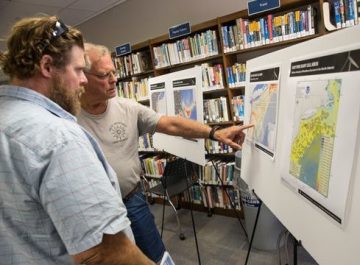
Offshore wind energy: fishermen ask for relief
Offshore windmills may be the future of energy here, but they’re presently a source of agitation to commercial fishermen. A vocal group of them, who aren’t necessarily opposed to windmills but just the placement of them on or near fishing grounds, which if you ask them is anywhere the water is salt, gave the Bureau of Ocean Energy Management their two cents at a public meeting Thursday. “All of these areas are prime scallop grounds. We’re not going to take any of this lying down,” said Arthur Osche, a member of the Point Pleasant Fishermen’s Dock Co-operative. Osche was referring to fishing grounds in Hudson North and Hudson South, two designated wind farm lease sites that start about 17 miles east of the coastline here. Fellow co-operative dock member Jim Lovgren said if their access to the grounds is restricted then they should be paid for the economic loss. “Mark off the area and then compensate us,” said Lovgren. >click to read<
Maximum Sustainable Yield: Just More Management Delusion or a Bureaucratic Con?
Dick Grachek
A note from Dick: Jim Lovgren’s comprehensive article on NOAA science and NOAA’s approach to Fluke management inspired me to tune up and post this piece I wrote on Maximum Sustainable Yield—the dehumanized, bookkeeping exercise that passes for the management approach of choice. (Warning: It’s a bit long, but I think it has relevance) Jim Lovgren – Fishery managers responsible for Summer Flounder mismanagement – click here
Maximum Sustainable Yield: Just More Management Delusion or a Bureaucratic Con?
Even if getting out from under the management fantasy of the “extinction delusion” could somehow become a reality, an essential overhaul of the basic goals of fishery management is necessary and must begin by asking the obvious—but totally neglected—question, what exactly is all this management supposed to accomplish, anyway? Maximum Sustainable Yield: Stable and Sustainable Stocks, Right? Well…actually, managing the fisheries to MSY is all wrong.
MSY accomplishes nothing more than stock population instability. One of the major mechanisms of this MSY approach is engineering the taking of large fish out of a population in some formulaic proportion to the young recruited into that particular stock. This is a naive and simplistic notion of stock dynamics. It completely ignores a myriad of natural or “biological-environmental” factors that govern fish survival and growth and population.
Michael Weber, special assistant to the chief of the National Marine Fisheries Service in 2002: “Like other, later scientific formulations that were incorporated in fisheries policy, the limitations of MSY… were largely ignored by decision makers and often by scientists. Among other shortcomings, these models assumed that the environment itself did not fluctuate and that interactions among fish populations had minimal effect. Neither assumption was borne out in reality.”
Carleton Ray, venerable and revered conservation scientist at the University of Virginia: “Science can be just as obstinate as any other field. And the traditionalists in science were the population dynamicists, who were very conservation-oriented, but felt the key was better use of MSY. In fact, when MSY first came around everyone thought it was a breakthrough in conservation, and it turned out to be one of the problems. Now it’s been shown, more or less, that we were right: In management, you can’t separate our animals from their environment.”
MSY actually works against stock health because it is the large slower growing fish that stabilize a stock. MSY by focusing on counting recruits and bartering their numbers for balancing out the taking of older larger fish renders populations consisting mainly of relatively small young fast growing fish—faster growth rate, looks good on fish stock health reports, looks like the stock is improving rapidly, but faster-growth means greater oscillations and greater unpredictability over the long run. A healthy stock is a stock with a stable slower-growing multi-year class population—not a hoard of confused rampaging adolescents eating themselves out of house and home.
This simplistic MSY stock assessment and management dynamic of counting young fish (a mission impossible to begin with) as barter for taking the larger fish results in the equally simplistic management idea that to control commercial and recreational fishing mortality is to control the health of the fish stocks. This assumes, incorrectly, that all other factors in the fishes’ natural environment are fixed or constant or non-existent.
Probably, the only element in the fishes’ environment that the regulators can comprehend, measure, and control is commercial and recreational fishing activity. So, if the “counted” young recruits don’t jive with the arbitrary bartering formula and correspond to the large fish taken, then it’s a clear case of “Overfishing”???
Yup, it certainly is… and so that’s where management will focus energy, funding, and enforcement! Stop the greedy and destructive fishermen form Overfishing!
Again, it’s apparent that NOAA is assessing and managing the stocks to the forgone conclusion that the stocks are in dire shape since the scientists can’t find any fish, and they can’t find any fish because they’re all gone, and they’re all gone because the handful of fishermen that are left (after catch shares consolidation), are overfishing. MSY generated assessments can prove it!
Actually, MSY is quite effective and does work very nicely—for the regulators, but not for anything else. It works by providing relatively friendly and easily digested bookkeeping data for convoluted stock assessment computer models. And the “overfishing” conclusions rendered by this bogus approach to stock population health become self-serving bureaucratic justification for jobs and academic claims to fame. And perhaps also a significant motivating factor for the popularity of MSY bungling, is that it also provides NOAA’s Eco-Non-Government Organization “partners” i.e., Pew, EDF, Oceana, NRDC, etc. a sweet marketing platform for donation harvesting. It’s simple: “…just give us funding and we’ll send in our battery of lawyers to stop the overfishing that is indicated by the MSY based analyses. Brilliant, eh?
A Better Idea: Respect the Resource, Respect the People Who Feed You, and Preserve the Small Boat Fleet or Let’s Get Back to Optimum Yield.
“[There is a]…critical role that sound science and good governance —that is, inclusive, transparent co-management between government, and industry and stakeholders — plays in ensuring the sustainability of fisheries.” Ecotrust Canada (intro. to “A Cautionary Tale”)
The fisheries can be successfully managed. With integrity, common sense, and clarity of purpose it can be done. Fishermen understand that successful effective management is absolutely necessary for the survival of the fish and the fishing communities; but clearly, micro-management, as currently practiced, is impossible.
The problems managing the complicated Northeast Multi-Species Fishery have to do with some very unrealistic ideas about fish and fishing at NOAA. Fisheries problems that are attributed to dwindling stocks and uncooperative rogue fishermen mis-reporting their catch are, in truth, most often created by this huge, detached, despotic, and external agenda-driven, and mismanaged, NOAA bureaucracy, unwieldy, inflexible, overwhelmed, confused, and inept. An agency that is NGO Lawsuit cowed, with a culture of entrenched and defensive conservative viewpoints will never be effective.
Fishing cannot be managed from sound-bites or marketing slogans created by environmental organizations with a prejudice and an agenda. Good scientific observation, accurate stock assessments, and intelligent co-governance do not result if there is a predisposition or a given blind allegiance to the postulate that “the fish are endangered due to illegal and immoral overfishing”.
Fishing also cannot be managed from an academic economist’s or biologist’s point of view only. Fishing is a multi-faceted issue and requires a multi-discipline approach, including sociologists, social-psychologists, social-anthropologists, and social-historians, and especially must include the fishermen and fish handlers whose lives will be directly and sometimes drastically affected by the outcome of the regulation decisions—and who have daily, first-hand vital information.
The words “men” and “women”, the humans, have to be put back and coupled with the term “fishers” (the neutered and dehumanized term so favored by the anti-fishing theorists). Fishing is an interaction between fish and people.
Optimum Yield (OY) is actually the stated goal of all this management, mandated by the original MSA (Magnuson-Stevens Act), or as earlier called, the MFCMA (Magnuson Fishery Conservation and Management Act).
Although never adequately defined, OY certainly includes the people aspect of the fisheries, i.e., considering the relevant ecological, economic, and social factors. The Act stated in Sec.3 (18): “The term ‘optimum’, with respect to the yield from a fishery, means the amount of fish – A) which will provide the greatest overall benefit to the Nation, with particular reference to food production and recreational opportunities; and B) which is prescribed as such on the basis of the maximum sustainable yield from such a fishery, as modified by any relevant economic, social, or ecological factor.”
In that above passage what seems most relevant to this discussion of MSY is that “The Act” clearly states “MSY as modified by economic, social, or ecological factors”.
In other words the “scientific” results of MSY oriented assessments become a preliminary starting out place and are to be mitigated by the non-scientific factors, economic, social, and ecological.
The National Standards of the Fishery Management Act required that all management plans take into account OY, or the non-scientific, the more human side, of the equation:
The Act Sec. 2 (b) (4), “… to provide for the preparation and implementation, in accordance with national standards, of fishery management plans which will achieve and maintain, on a continuing basis, the optimal yield from each fishery.”
Truly respecting OY and socio-economic-cultural and ecological aspects of the fisheries, would most likely encourage a diverse fleet of privately owned boats. These fishing operations have conservation systems and limits built in. They are restricted by weather and range and limited funding, by market prices, fuel and mechanical repair costs, and consequently they have unavoidable periods of down time (not-fishing). Due to narrow financial margins and weather safety issues, they can only fish for the stocks that are plentiful and within reach of their ports.
For these local family owned and funded operations, It is simply not financially viable for them to fish on depleted stocks or to stay at sea through dangerous weather conditions. These built-in restraints, coupled with cooperative-surveying and reasonably accurate science and assessments informing regulators, would be intelligent management and do much toward securing the health of the resource and the fishery.
However what we do have, that is passed off as “management”, is really the brandishing of the “overfishing” war cry, buttressed with faulty MSY assessment “proof”. This has moved management into the privatization and consolidation of the fishery through “Catch Shares”—as a measure to save the stocks from disappearing into “oceans of jellyfish”. The NOAA managers have also found the need to constantly tighten allowable catch quotas, or the amount of fish that fishermen are “allowed” to land, in order to thwart “rampant overfishing”— not to mention the NOAA/Oceana mandate of industry funded observers and monitors in order to enforce the ridiculous regulations. And oh yes, also the observers/monitors stop the millions upon millions of pounds of “Wasted Fish” discards— due to inefficient and greedy fishing practices, not disproportionate regulations.
Sadly, all this MSY borne assessments “fisheries managing” has resulted in the dismantling and disappearance of a large portion of the independent family owned and operated fishing fleets. And a fleet of many fishery-diverse “inefficient” boats would sustain the fish, preserve jobs, provide a vital healthy source of fresh food daily, and keep the traditional coastal fishing communities thriving.
The issues and problems facing the fishing industry are not insurmountable. But there needs to be some clarity and integrity, some honest and intelligent communication informing the purpose and long term goals for the fisheries. There can’t be hidden corporate agendas or personal ambition driven politics if the management endeavor is ever going to succeed in preserving the resource and the fishing communities.
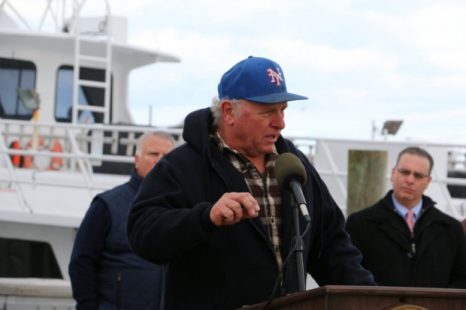
N.J. fishermen, officials demand feds back off of proposed flounder limits
In a unified show of support, New Jersey officials and leaders of the state’s fishing industry said Friday they are demanding the federal government abandon plans to cut the amount of fluke to be harvested this year. Insisting the proposed new limits will devastate an industry important to New Jersey’s economy, the government and industry representatives said they’re prepared to mount a legal fight, if necessary, to fight “ridiculous” limits that were based on “flawed” data. Jim Lovgren, a fishing boat captain and director of the Fishermen’s Dock Cooperative, said fishermen already experienced a 30-percent reduction in limits last year and face yet another 17- or 18-percent cut next year. The Point Pleasant Beach cooperative he heads pulls in about 2 million pounds of flounder annually. “Taking 30 percent of that last year hurt. It hurt me economically. It hurt everybody over there. It hurt everybody here,” he said to the crowd. Photo gallery of 21 images, Read the story here 16:54
“Delusions of a Mad Man”. The story of Harvey Haddock, a fisherman who finally had enough and decided to do something about it
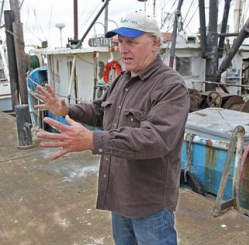 READ THIS! “Delusions of a Mad Man”. Excerpted from a novel in progress by Jim Lovgren. Harvey Haddock cursed his father, why did he have to be a commercial fisherman? He could have been anything, a doctor, lawyer, porno star, anything but a damn commercial fisherman. He knew it was wrong to curse his father, but his rage needed an outlet and since his problems started with his career choice, his anger naturally returned to its birthplace. His father was a fisherman, and so was his grandfather, brother, and uncles, it seemed like everybody in his family at some time was a fisherman, probably going all the way back to Sweden where his ancestors had originated. The difference was that in other countries, and even in America until a few years ago, Commercial fisherman were respected as the hard working food providers that they were, but somehow something went wrong in America. Read the story here 16:05
READ THIS! “Delusions of a Mad Man”. Excerpted from a novel in progress by Jim Lovgren. Harvey Haddock cursed his father, why did he have to be a commercial fisherman? He could have been anything, a doctor, lawyer, porno star, anything but a damn commercial fisherman. He knew it was wrong to curse his father, but his rage needed an outlet and since his problems started with his career choice, his anger naturally returned to its birthplace. His father was a fisherman, and so was his grandfather, brother, and uncles, it seemed like everybody in his family at some time was a fisherman, probably going all the way back to Sweden where his ancestors had originated. The difference was that in other countries, and even in America until a few years ago, Commercial fisherman were respected as the hard working food providers that they were, but somehow something went wrong in America. Read the story here 16:05
N.J. fishermen fear loss of huge underwater sand hill, the Manasquan Ridge
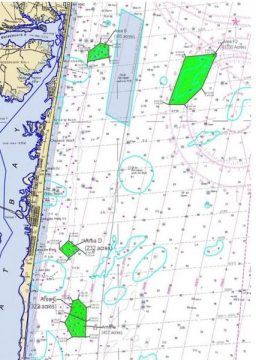 The appearance of the 123-foot offshore supply vessel Scarlett Isabella on the Manasquan Ridge is a bad omen to Capt. Jim Lovgren, a Point Pleasant Beach commercial fishermen. The Scarlett was in the hire of the Bureau of Ocean Energy Management, which is looking for potential sand on the outer continental shelf that could be pumped up onto the Jersey beach. Tampering with these sand beds, which are long-established fishing areas, could reshape the fishing communities at the Shore, fishermen say. The ridge, which starts to rise off the ocean floor 5 ½ miles southeast of Manasquan Inlet, is one of those potential resources of sand. “Last year word was that Manasquan Ridge was a last resort for beach replenishment use. The fact that they are paying a survey vessel to crisscross it clearly says something different,” said Lovgren, who sits on the Executive Board of the Garden State Seafood Association. Fishermen have been weary of a conflict with the Army Corps of Engineers over the ridge, and others nearby, which they depend on to hold fish. Read the story here 17:48
The appearance of the 123-foot offshore supply vessel Scarlett Isabella on the Manasquan Ridge is a bad omen to Capt. Jim Lovgren, a Point Pleasant Beach commercial fishermen. The Scarlett was in the hire of the Bureau of Ocean Energy Management, which is looking for potential sand on the outer continental shelf that could be pumped up onto the Jersey beach. Tampering with these sand beds, which are long-established fishing areas, could reshape the fishing communities at the Shore, fishermen say. The ridge, which starts to rise off the ocean floor 5 ½ miles southeast of Manasquan Inlet, is one of those potential resources of sand. “Last year word was that Manasquan Ridge was a last resort for beach replenishment use. The fact that they are paying a survey vessel to crisscross it clearly says something different,” said Lovgren, who sits on the Executive Board of the Garden State Seafood Association. Fishermen have been weary of a conflict with the Army Corps of Engineers over the ridge, and others nearby, which they depend on to hold fish. Read the story here 17:48
Seismic Blasting: More Dots
Press briefing on Atlantic seismic surveys
Erik Milito, API director upstream and industry operations
Thursday, February 27, 2014
“The economic benefits of opening the Atlantic to offshore oil and natural gas development will be felt all across the country…”
“In order to achieve these gains, the government must permit seismic surveys in the Atlantic and hold Atlantic lease sales under the next five-year plan for offshore oil and natural. That plan will cover lease sales from the second half of 2017 to the first half of 2022.”
“Seismic surveys work by recording how sound waves generated near the surface reflect off the rocks beneath the ocean floor. These recordings allow scientists to produce detailed 3-dimensional maps that give engineers the information they need to identify the safest and most efficient drilling locations.”
The oil companies are among the most powerful entities on the planet and they want the ocean. (http://www.boem.gov/5-year/
They also want to know the “most efficient drilling locations” so they’re going to start seismic blasting along the East Coast and are busy sending out their initial public opinion cover-stories; what’s really interesting though, is how the agencies of the government, the academic institutions, and the environmental groups, all in a coordinated way, seem to fall in line to be the point men dutifully performing the marketing prevarications for these mammoth companies.
In the case which I outline below, they all prepare the way for seismic blasting along with a cover for the dead mammals and fish that will appear on the local beaches. The agencies and the Oceana “conservation” group set up the cover story of “…not to worry all that seismic blasting is approved by your trusted eco-guardian government agencies overseeing the research for safely restoring the beach sands of NJ”. More cover or diversion is provided by Oceana’s latest “report” planting the idea in the minds of the public that should you come across a few dead marine mammals on the beach, it’s those greedy fishermen again destroying life with their bycatch and destructive fishing gear.
There are a few more dots to connect here and the strategies involved become pretty clear.
Dot #1
Big Oil owns Department of Commerce’s NOAA and Department of Interior’s BOEM
“The final Environmental Impact Statement (EIS), released Thursday by the U.S. Department of Interior’s Bureau of Ocean Energy Management (BOEM), outlines measures for minimizing the impact on wildlife that are especially sensitive to the intense sound impulses used to prospect for energy resources beneath the seafloor. (See related, ‘Study: Planning Can Protect Whales in Seismic Surveys.’)”
“BOEM Director Tommy Beaudreau said in a statement that the agency is ‘employing a comprehensive adaptive management strategy’ that takes into account the fact that scientific knowledge about the Atlantic Ocean is constantly changing and building. ‘New information and analyses will continue to be developed over time,’ he said.”
‘The Department and BOEM have been steadfast in our commitment to balancing the need for understanding offshore energy resources with the protection of the human and marine environment using the best available science as the basis of this environmental review’ Beaudreau said.” [He’s good isn’t he?]
http://news.
And as for NOAA’s National Marine Fisheries Service’s role: (Thanks to Fisherynation.com for ferreting out this following NJ article)
Groups oppose ocean blasting plan off N.J. coast
March 26, 2014, 11:30 AM Last updated: Wednesday, March 26, 2014, 11:57 AM
By WAYNE PARRY
Associated Press
“Environmental and fishing groups are opposing a plan by three universities and the National Science Foundation to carry out seismic blast tests on the ocean floor off the New Jersey coast this summer.
The groups say the tests could harm or kill marine life including dolphins, whales and many types of fish.
The National Marine Fisheries Service [NOAA] has proposed granting permission for the tests, which would run from early June to mid-July about 15 miles off Barnegat Bay. The tests are designed to study the arrangement of sediments deposited on the ocean floor during times of changing global sea levels dating back 60 million years [Well worth destroying the Mid-Atlantic Squid Fishery].
A spokeswoman for Columbia University’s Lamont-Doherty Earth Observatory did not immediately respond to a request for comment Wednesday.
The University of Texas [Hmm…University of Texas—do you smell oil?] and Rutgers University also would participate in the study.
Capt. Jim Lovgren, director of the Fisherman’s Dock Cooperative in Point Pleasant Beach, questioned the value of the testing.
‘Squid and summer flounder are very important fisheries and this is a key habitat area for them,’ he said. ‘It has been documented that marine life is impacted by seismic testing. What is the point of this study compared to the risks involved?’
The groups say seismic air guns and three other acoustic blast technologies that would be used in the study all have known potential to harm marine life.” [Underlines are mine]http://www.northjersey.
So here with the National Science Foundation, three universities listed above, the “other agency” such as Department of Interior’s BOEM, you have the “research of other agencies and academic institutions” as mysteriously prophesied in the NOAA flyer below (see underlines) which is Dot #2.
Dot #2 NOAA’s “cover story” and preparing us for this latest oil industry seismic blasting Murphy game: From an email received from NOAA dated March 26, 2014:
Protecting Offshore Habitats while Rebuilding New Jersey Beaches
“Our staff works with the Corps to help identify and evaluate options for reducing impacts to these ecologically rich habitats. Some options may include simply maintaining the vertical relief (elevation) of shoals and ridges, avoiding areas of high quality surf clam habitat and conducting ongoing monitoring to assess changes to ocean bottom conditions due to the dredging activity. Where we can, we also support the research of other agencies and academic institutions. Through further study, we can learn more about the functions and habitat values of offshore shoals and ridges and the effects of sand mining on these special areas.” [Underlines are mine]
https://www.nero.noaa.gov/
Now, that all looks quite commendable, doesn’t it? They are doing the research while restoring the NJ beaches and researching and protecting all the marine life so carefully, all at the same time. However, by connecting a few dots—and if one was somewhat distrusting of the motivations behind this constant messing with the ocean, and even noticing perhaps that the NOAA article above could be seen as a field-softening sort of “Stalking Horse” coordinated with the latest stop-the-fishing campaign from the luminaries at Oceana that blames the death of birds, whales, and other marine mammals, on destructive fishing gear and greedy fishermen’s bycatch—this might be seen as preparing the citizens for what’s coming next: seismic blasting for gas and oil rigs—and a lot of dead mammals and fish.
Dot #3 Oceana was started up mainly with Pew money and Pew money is oil money. http://www.fishtruth.net/
Therefore, as this sets up, if any whales, sharks, sea birds, sea turtles, and fish happen to wash up on the NJ beach, guess where the public’s ire will focus. On the local fishing operations, of course, after Oceana has saturated the eco-media with horror stories of reckless fishermen slaughtering ocean creatures with, “…trawls as wide as football fields, longlines extending up to 50 miles with thousands of baited hooks and gillnets up to two miles long…” thus causing “Hundreds of thousands of dolphins, whales, sharks, sea birds, sea turtles and fish needlessly die each year as a result of indiscriminate fishing gear,” said Amanda Keledjian, report author and marine scientist at Oceana.
What’s really interesting is that Oceana was saying the same exact things about seismic blasting and the “dirty offshore drilling” not too long ago that they are now attributing to fishing:
“Seismic airgun testing currently being proposed in the Atlantic will injure 138,500 whales and dolphins and disturb millions more, according to government estimates.
“Seismic airguns are towed behind ships and shoot loud blasts of compressed air through the water and miles into the seabed, which reflect back information about buried oil and gas deposits. These blasts harm marine mammals, sea turtles, fish and other wildlife.
Impacts include temporary and permanent hearing loss, abandonment of habitat, disruption of mating and feeding, and even beach strandings and death. For whales and dolphins, which rely on their hearing to find food, communicate, and reproduce, being able to hear is a life or death matter.
Airgun blasts kill fish eggs and larvae and scare away fish from important habitats. Following seismic surveys catch rates of cod and haddock declined by 40 to 80 percent for thousands of miles.
In addition to being devastating for marine life, seismic airguns are the first step toward dangerous and dirty offshore drilling with associated habitat destruction, oil spills and contribution to climate change and ocean acidification.
Oceana is working to halt the use of seismic airguns, and stop the expansion of dangerous offshore drilling.”
http://oceana.org/en/our-work/
But now it’s the “nine dirtiest fisheries” according to Oceana’s latest: “WASTED CATCH: UNSOLVED PROBLEMS IN U.S. FISHERIES” that are to blame for the carcasses you might find on the beach.
“Hundreds of thousands of dolphins, whales, sharks, sea birds, sea turtles and fish needlessly die each year as a result of indiscriminate fishing gear,”
“Bycatch is the catch of non-target fish and oceanwildlife, including what is brought to port and whatis discarded at sea. It is one of the most significant threats to maintaining healthy marine ecosystems.”
http://oceana.org/sites/
To summarize:
Dot #1 Big Oil wants to get a more recent Seismic blasting survey of the bottom off of the Mid-Atlantic States in preparation for realizing their 5 year plan for many ocean gas and oil rigs.
This connects to Dot #2 NOAA’s cover story that Seismic Blasting is only research to facilitate the saving of the marine environment while allowing the restoration of NJ beaches after Hurricane Sandy.
This connects to Dot #3 where Oceana is telling you that, these days, the dead marine mammals and fish you most likely trip over while walking on the beach are the result of “dirty fisheries” and not “dirty oil” or “dirty seismic blasting”.
Opposition Mounts to Seismic Blasting off the Jersey Shore
 “We’re concerned here,” said Capt. Jim Lovgren of the in Point Pleasant Beach at a small rally against the blasting held there Friday morning. “That’s not a dinner bell for fish. If you’re in the water and you hear that sound, you flee. You don’t know what it is, and it’s hurting you.” Read more here 16:46
“We’re concerned here,” said Capt. Jim Lovgren of the in Point Pleasant Beach at a small rally against the blasting held there Friday morning. “That’s not a dinner bell for fish. If you’re in the water and you hear that sound, you flee. You don’t know what it is, and it’s hurting you.” Read more here 16:46
Oceana: Marine Life and Coastal Economies Threatened by Seismic Airgun Use in Atlantic Ocean – Where ya been!
These people amuse me sometimes. Jim Lovgren, a fisherman from NJ asked me to post this information. May 3, 2012 – borehead, don’t know whether you saw these or not, but these are my written comments to BOEM, feel free to use the comments, they need to be spread around as much as possible. I wrote Have you heard about the slaughter that lies ahead for those marine mammals we’ve been saving? continued
WASHINGTON – April 16, 2013 – Oceana released a new report today showing that marine life and coastal economies along the Atlantic Ocean are threatened by seismic airguns used in testing for offshore oil and gas. continued
By the by, Oceana, This is the trade off for those windmills you like so much! “Smart from the Start”, all of the above strategy of the Obama administration.
N.J. fishing industry works to recover from Sandy-POINT PLEASANT BEACH, N.J.
Commercial fisherman Jim Lovgren has navigated some rough seas lately. 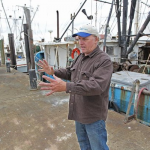 First, his 70-foot trawler, Viking II, swamped in high waves and sank 80 miles off Cape May in late September.
First, his 70-foot trawler, Viking II, swamped in high waves and sank 80 miles off Cape May in late September.
Then, on Oct. 22, Sandy took a dramatic swipe at the Fisherman’s Dock Cooperative, where Lovgren is a director and about a dozen third- and fourth-generation fishermen bring their catch to be sold at markets throughout the country. http://www.philly.com/philly/news/20121120_N_J__fishing_industry_works_to_recover_from_Sandy.html

Mafia tactics employed at New Bedford scallop hearing
On March 20 th at the public hearing for Amendment 21 General Category Scallops in New Bedford an incident occurred in the audience that raises serious questions about IFQ management and the consequences of them. A New Jersey fisherman, who was in the area looking at boats for sale, decided to attend the public hearing that night. As he entered the room he was approached by a well known local fishing industry entrepreneur, who now sells boats and fishing quota , and who he has previously done business with. He is also handling the sale of the boat the fisherman is looking to buy. He aggressively gave the fisherman the fifth degree of questioning about why he was at the meeting, leaving said fisherman with an uneasy feeling of intimidation, as the questioning implied don’t testify against the plan. >click to read<09:00
Harvey Haddock on fisherman’s rights.
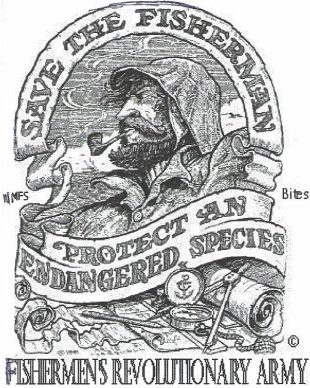 On a cold windy morning at the Fishermans Dock Co-op, all the boats are in, and a couple of small groups of fishermen are scattered at the docks unloading spots, generally discussing the last few days of fishing, and invariably complaining about one regulation or another. Henry’s in a hurry to the office today, it seems the morning coffee has done its magic, and he needs to make a deposit for Alice and Lil, the office secretary’s. He hurries through the dock careful not to slip on the ice, and enters the warm office, heads right, passing Alice sitting at her desk, and Lil, in the next room.
On a cold windy morning at the Fishermans Dock Co-op, all the boats are in, and a couple of small groups of fishermen are scattered at the docks unloading spots, generally discussing the last few days of fishing, and invariably complaining about one regulation or another. Henry’s in a hurry to the office today, it seems the morning coffee has done its magic, and he needs to make a deposit for Alice and Lil, the office secretary’s. He hurries through the dock careful not to slip on the ice, and enters the warm office, heads right, passing Alice sitting at her desk, and Lil, in the next room.
Again? Says Alice
It’s my first time today, I tried the outside bathroom, but the door was locked, and the dog ate the toilet paper, Henry lied, as he hurried to the toilet and closed the door. Lil smirked as he passed. Shortly after, business finished, Henry walks out.
Sorry about that , He says.
In walks Bill Ford. “Beat you to it” says Henry.
“Damn, I hope you opened the window”
“Yea, I even sprayed”
Henry walks to the front of the office where John Cole the dock manager sits behind his desk, constantly manning the phone, selling fish and finding out what they sold for. Scattered around the office are a half dozen chairs where the usual cast of characters are gathered. Jimmy Mathews, Denis Lovgren, Tom Anderson, and Randy Gant are here this morning, they come in the office to find out the prices of yesterday’s catch, and just to bug John when he’s busiest. Henry takes an empty seat in between Jimmy and Denis.
“Morning”, “How’s it going?” “Morning”. “Morning”.
Jimmy address’s Henry, “How about those Pirates?”
“It’s December Jim, I think they’re in hibernation right now”
“Yea but its only 65 days before spring training” states Jimmy.
“Jim, It’s football season, says Denis. Tom and Randy are sitting across from them laughing to each other over Jimmy’s Pirate obsession. No matter what time of year it is, he always wants to talk about baseball, and the Pirates in particular. Bill Ford now enters the room tightening his belt.
“Damn Henry, It smelled like something crawled up your ass and died”.
“Must’ve been someone I ate” replied Henry.
“ Well you better flip her over next time”.
Everybody laughs. John gets off the phone. “Well?” asks Denis.
“Well what?”
“How’s the prices?”
“I’m getting 50 and 55 cent returns” says John.
“What’s that to the boat?
“35 to 40”.
“Well, I guess that beats a kick in the ass”, says Randy.
“Anybody else got fish?” Asks Henry.
“Point Judith”, says John, “Where’s your brother this morning?”
“Probably sleeping late, like usual”. Harvey did like sleeping late when they had a day off, while everybody else would be down the dock at 8, 8:30, he’d arrive after 9.
Tom says to no one in particular, ”Well I got to go over the net, I’m outta here”.
Randy gets up also, “I’m due for an oil change, John can I get a few cans of 15/40?”
“Yea, go tell James, he’ll get them for you”. As they’re leaving, along comes Harvey.
“Morning”, “Morning”, “Hey Tom, Randy,”.
“What’s up?” “How you doing?”
“You’re a motley looking crew today”, says Harvey.
“We’re still gagging from your brother”, says Denis.
“Hey, It’s not just me. Bill piled on also”
“You should’ve flushed” says Bill.
“Henry and Harvey arrive and the conversation always ends up in the toilet” Says John.
“How are prices, John?” Asks Harvey.
“Everybody else got a dollar, your fish were 15 cents. Come down sooner and you may get more”.
“Denis, how were the fish?” Asks Harvey. John loves to bust balls especially Harvey’s, so Harvey is used to asking someone else for the truth.
“50 to 55 cent returns”.
“Well I guess that beats a kick in the ass”.
“So what’s the latest management bullshit?” Asks Denis.
“It sounds like the New England Council is going to cut back Days at sea” says Henry.
“Really? How Much? Asks Denis.
“Maybe Half”.
“Half? You gotta be kidding”. Says Harvey.
“Good thing I don’t have any”. Says Bill.
“ Why do they want to do that?” Asks Jimmy.
“More fallout from that enviro lawsuit. The science center says Cod and Haddock are collapsing, along with Yellowtails”.
“Yea, but we don’t have any of them down here, why should we take a hit?” Asks Harvey.
“Ask the Council Gods, they say if New England has to suffer so do you”.
“Fuckers” Says Jimmy.
“Hey, listen, I’ve been thinking, and…”
“Oh boy, now we’re in for it. Harvey’s been thinking. Is this a long story?” Asks John sarcastically.
“Stop. I’ve given this a lot of thought”.
“I guess you’ve got none left then. Who’d you give it too?” Says John.
“Alright, John, seriously, listen”.
“I’m busy trying to sell your crummy fish”. John picks up the phone and fakes dialing.
“Henry, our Grandfather immigrated here after WW one, and soon his seven brothers followed him, Right?”
“Yea”….
“At one point they all fished along the Jersey shore, providing food to our country while at the same time earning an honest living. They were farmers of the sea, yet they never had what farmer’s had”.
“ What was that? Asked Denis.
“They couldn’t buy the ocean. Europeans came here to settle and if they had money, they bought land. If they didn’t, they worked until they earned enough so they could. Farmers owned their land. Nobody owned the fish in the ocean. Nobody until Uncle Sam decided that he did in 1976 when congress passed the Magnuson act and created the 200 mile exclusive economic zone creating the National Marine Fisheries Service and giving the U.S. government exclusive rights to all the natural resources within that range. One of the original premises of the NMFS was to promote and protect our country’s fishermen, and fisheries. Yet over time, it seems like all they’ve done is destroy us. They’ve taken away fishery after fishery and have mismanaged the stocks so bad you can’t make a living anymore. Then they blame us. I didn’t let the Russians wipe out the Georges Bank, and Grand Banks. The State Department did. They saw what was happening off our coast, hundreds of factory trawlers vacuuming up everything out there. They didn’t care. Some of those ships were our allies, Spanish, Japanese, Portuguese, Italian, since you couldn’t selectively kick out one country, you’d have to kick out all of them, the State department made the decision to allow the raping to continue, sacrificing the richest fishing grounds in the world to our mortal enemy, so as not to offend a small group of fishermen from a few friendly countries. They used us as poker chips”.
“O.K.”, says Henry. “That’s all true. But it’s the past. What can you do now?”
“Sue em. A takings lawsuit”.
“How can you sue over something you never owned?” asks Denis.
“You know how hard it is to win a takings lawsuit against the government? Even against a town? asks John.
“Yea, I know. It’s just not right. The Indians have been granted fishing rights, how come we haven’t?” asks Harvey.
“Well, we did steal their country lock, stock, and barrel, while practically wiping them off the face of the earth”, says Henry. “It’s the least we could do, give them some fish”.
“Don’t forget, we gave them casino’s and cholera, also,” Says Jim.
“We should get casino’s… and floating whorehouses”, adds Harvey.
“Well I guess that’s where your thinking ends, Harvey”. Says John.
“Seriously, this country was founded by European fishermen chasing Codfish on the Georges, and the Grand banks, if we conveniently forget that the Indians were already here. So where are our rights? What gave the U.S. government the right to suddenly proclaim all the fish from 12 miles to 200 miles is theirs? What about the U.S. fishing families that have been fishing in those international waters for years before good ole uncle sam decided that he owned them all? Where are our rights? Aren’t we like an indigenous people? Asks Harvey.
“You’re the cowboys of the sea”. Says John.
“No, we’re more like the Indians. Magnuson promised the world but gave us cholera and financial genocide. Adolph would be proud of NMFS”. Says Harvey.
“They don’t like when you call them Nazi’s”, says John.
“Truth hurts” replies Harvey.
“Nazi’s didn’t wipe out the Indians” adds Jimmy.
“Alright, get out of here. I’ve heard enough bullshit for one day”. Says John.
Everybody leaves except John who still sits in his chair, an exasperated look on his face.



































